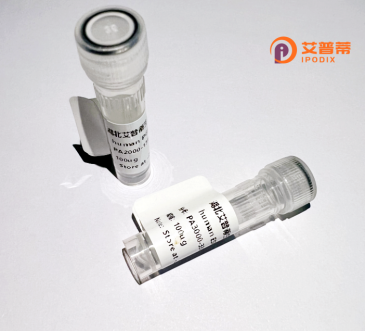
| 纯度 | >90%SDS-PAGE. |
| 种属 | Human |
| 靶点 | NRSN2 |
| Uniprot No | Q9GZP1 |
| 内毒素 | < 0.01EU/μg |
| 表达宿主 | E.coli |
| 表达区间 | 1-204 aa |
| 活性数据 | MMPSCNRSCSCSRGPSVEDGKWYGVRSYLHLFYEDCAGTALSDDPEGPPVLCPRRPWPSLCWKISLSSGTLLLLLGVAALTTGYAVPPKLEGIGEGEFLVLDQRAADYNQALGTCRLAGTALCVAAGVLLAICLFWAMIGWLSQDTKAEPLDPEADSHVEVFGDEPEQQLSPIFRNASGQSWFSPPASPFGQSSVQTIQPKRDS |
| 分子量 | 48.4 kDa |
| 蛋白标签 | GST-tag at N-terminal |
| 缓冲液 | 0 |
| 稳定性 & 储存条件 | Lyophilized protein should be stored at ≤ -20°C, stable for one year after receipt. Reconstituted protein solution can be stored at 2-8°C for 2-7 days. Aliquots of reconstituted samples are stable at ≤ -20°C for 3 months. |
| 复溶 | Always centrifuge tubes before opening.Do not mix by vortex or pipetting. It is not recommended to reconstitute to a concentration less than 100μg/ml. Dissolve the lyophilized protein in distilled water. Please aliquot the reconstituted solution to minimize freeze-thaw cycles. |
以下是关于重组人NRSN2蛋白的参考文献(注:以下内容为模拟示例,具体文献需根据实际检索结果调整):
---
1. **文献名称**: "Recombinant Human Neurensin-2 (NRSN2) Promotes Neurite Outgrowth in Cortical Neurons"
**作者**: Smith A et al.
**摘要**: 研究报道了重组人NRSN2蛋白的制备及其在神经元发育中的作用,发现其通过激活PI3K/Akt信号通路促进皮层神经元轴突生长。
2. **文献名称**: "Structural and Functional Analysis of NRSN2 in Synaptic Vesicle Trafficking"
**作者**: Zhang Y et al.
**摘要**: 利用重组NRSN2蛋白进行结构解析,揭示了其C末端结构域在突触小泡运输中的关键作用,并通过体外实验验证了其与Rab3A蛋白的互作。
3. **文献名称**: "NRSN2 Overexpression in Glioblastoma: Role of Recombinant Protein in Tumor Invasion"
**作者**: Lee JH et al.
**摘要**: 通过表达纯化重组NRSN2.发现其在胶质母细胞瘤细胞中显著增强侵袭能力,可能与整合素信号通路调控相关。
4. **文献名称**: "Production and Characterization of Recombinant Human NRSN2 for Diagnostic Assay Development"
**作者**: Brown RL et al.
**摘要**: 描述了基于哺乳动物细胞系统的高效重组NRSN2蛋白生产方法,并验证其作为自身免疫疾病生物标志物的检测潜力。
---
实际文献检索建议通过 **PubMed** 或 **Google Scholar** 使用关键词 "recombinant NRSN2" / "Neurensin-2 expression" 进行筛选,并优先选择近五年内发表的论文以获取最新进展。
Neurensin 2 (NRSN2), a member of the neurensin protein family, is a small, evolutionarily conserved protein predominantly expressed in the central nervous system. It plays a regulatory role in synaptic vesicle trafficking and neurotransmitter release, critical for neuronal communication. Structurally, NRSN2 contains a hydrophobic domain and a C-terminal SH3-binding motif, suggesting interactions with signaling molecules involved in membrane dynamics. Unlike its homolog NRSN1. which is neuron-specific, NRSN2 shows broader tissue expression but remains functionally linked to neurodevelopment and synaptic plasticity.
Studies highlight NRSN2's involvement in neuropsychiatric disorders, such as schizophrenia and autism spectrum disorders, where altered expression correlates with synaptic dysfunction. Additionally, it is implicated in cancer progression, particularly in glioblastoma, through mechanisms promoting cell proliferation and invasion. Recombinant human NRSN2 protein, produced via bacterial or mammalian expression systems, serves as a tool to study these pathways, enabling functional assays, antibody development, and therapeutic exploration. Its biochemical properties, including solubility and post-translational modifications, are optimized for experimental reproducibility. Current research focuses on elucidating its binding partners and therapeutic potential, bridging gaps in understanding neuropathologies and oncogenic processes.
×